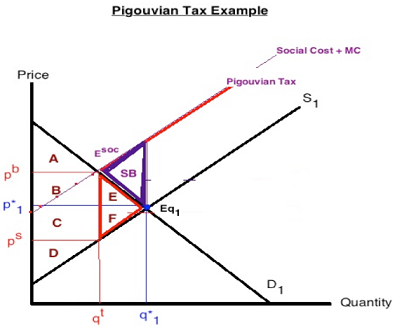Reference no: EM131165981
Question Set 1: Using the Pigouvian Tax Graph below, answer the following:

1. What is the market problem that a Pigouvian tax is supposed to resolve?
2. What is an example of a good that might exhibit this behavior (not from the website)?
3. What is an example of a good that has a Pigouvian tax on it?
4. On the graph, use the letters to represent the area of relevant parts of the graph:
1. What is the pre-tax consumer surplus?
2. What is the post-tax consumer surplus?
3. What is the pre-tax producer surplus?
4. What is the post-tax producer surplus?
5. What is the government revenue from the tax?
6. What is the change in total surplus due to the tax?
7. What is the term for this loss of surplus?
8. What are the social benefits of the tax?
9. In the good you mention above, what might this social benefit represent?
10. From the graph, the comparison of two areas dictates whether or not to implement the tax? What is this decision?
11. How do we know (or learn about) the size of deadweight loss and social benefit?
Question Set 2: Using the Pigouvian Subsidy Graph to Below, answer the following.

1. What is the market problem that a Pigouvian subsidy is supposed to resolve?
2. What is an example of a good that might exhibit this behavior (not from the website)?
3. What is an example of a good that has a Pigouvian subsidy on it?
4. On the graph, use the letters to represent the area of relevant parts of the graph:
1. What is the pre-subsidy consumer surplus?
2. What is the post-subsidy consumer surplus?
3. What is the pre-subsidy producer surplus?
4. What is the post-subsidy producer surplus?
5. What is the government cost of the subsidy?
6. What is the change in total surplus due to the subsidy?(Hint: it is negative)
7. What is the term for this loss of surplus?
8. What are the social benefits of the subsidy?
9. In the good you mention above, what might this social benefit represent?
10. From the graph, the comparison of two areas dictates whether or not to implement the subsidy? What is this decision?
11. How do we know (or learn about) the size of deadweight loss and social benefits?
|
Identify the type of interview and its approach
: Before you do this, develop a brief interview plan. After your partner interviews you, identify the type of interview, interview approach, and types of questions used.
|
|
Develop and implement strategic plan
: Foundation for group development and management in completion of Assessment - Describe the purpose for forming the team and the anticipated outcomes.
|
|
With whom do you think the u.s. supreme court sided in case
: The trucking company argued that the fee discriminates against trucks involved in both intrastate and interstate commerce because they spend less time carrying cargo in Michigan than do trucks involved with solely intrastate commerce. The state ar..
|
|
What is the sample space that we use for rolling two dice
: What is the sample space that we use for rolling two dice, a first one and then a second one? Using this sample space, explain why it is that if we roll two dice, the event "i dots are on top of the first die" and the event "j dots are on top of t..
|
|
What is the pre-tax consumer surplus
: On the graph, use the letters to represent the area of relevant parts of the graph: What is the pre-tax consumer surplus? What is the post-tax consumer surplus? What is the pre-tax producer surplus
|
|
Develop a brief jad plan
: Develop a brief JAD plan, select two techniques that will help identify improvements, and then develop an agenda. Conduct the session, using the agenda, and write your post-session report.
|
|
Do think harry breached his fiduciary duty in his capacity
: However, Harry maintained that out of those personal expenses, his cell phone bill, car repairs, gas, and health insurance were "necessary business expenses." Tom disputed this assertion. Do you think Harry breached his fiduciary duty in his capac..
|
|
What is the expected amount of money we draw on first draw
: What is the expected value of the total amount of money we draw? Does this expected value change if we draw the three coins all together?
|
|
What is the present value of liability
: If the relevant discount rate is 6.1 percent, what is the present value of this liability? (Enter your answer in dollars not in millions, e.g., 1,234,567. Do not round intermediate calculations and round your answer to 2 decimal places, e.g., 32.1..
|